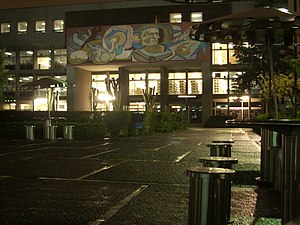Arnold Belkin
Arnold Belkin (born December 9, 1930 in Calgary , Alberta , † July 3, 1992 in Mexico City ) was a painter and graphic artist born in Canada and later living in Mexico , who also designed costumes for theater and ballet.
biography
Belkin's father was Russian, his mother English, both Jewish. As a teenager he attended the Emily Carr Institute of Art and Design in Vancouver .
Enthusiastic about the Mexican murales artists, he went to Mexico City in 1948 to meet Diego Rivera , José Clemente Orozco and David Alfaro Siqueiros personally. Here he attended the Escuela Nacional de Pintura, Escultura y Grabado “La Esmeralda” (ENPEG), where he learned from Agustín Lazo and Carlos Orozco , among others . As early as 1950 he painted his first mural at the Instituto Politécnico Nacional "! El Pueblo no quiere la Guerra!" ( Spanish for "The people don't want war" ), which was later destroyed. He learned Alfaro Siqueiros, with whom he discussed the cooperation at the murals "Patricios y Patricidas" ( " patrician and patricians" ) and " Cuauhtémoc " (in the Palacio de Bellas Artes was also friends) out. In 1952 his first solo exhibition took place. He learned metal engraving from Lola Cueto and the art of printing at the Escuela de Artes del Libro graphic school , and also worked with Guillermo Silva Sanz de Santamaría . In 1956 he painted “La Bahía de Acapulco” ( “The Bay of Acapulco ” ) at the Continental Hilton Hotel , which was also destroyed in an earthquake. Also in 1956 he became professor for wall painting techniques at the Universidad de las Américas . In 1957 he created “Escenas de Don Quijote” ( “Scenes of Don Quixote ” ) in Cuernavaca , 1959 his portable mural for the Warsaw Ghetto Uprising and from 1960 to 1961 he completed “Todos somos culpables” ( “All are guilty” ) in the penal institution of the Mexican capital . Together with Francisco Icaza , Francisco Corzas , José Luis Cuevas , Rafael Coronel , Leonel Góngora and Nacho López , he founded the artist group “Nueva Presencia”. In 1963 he exhibited at the Zora Gallery in Los Angeles and, along with Siqueiros, Icaza, and Tamayo, was one of the Mexican representatives at the International Award Exhibition at the Solomon R. Guggenheim Museum , New York. After that he painted, who until then had been painting figuratively, mostly abstract. In 1966 he painted “Las Festividades judías” ( “The Jewish Festivals” ) in the Kehila Ashkenazi de México synagogue , Mexico City. Two years later he went to Europe and worked there with the fresco painting of the European old masters.

He then lived in New York for some time, where he painted with other Latin American artists and then painted figuratively again. At the Lock Haven University of Pennsylvania he painted his first mural in the United States in 1971 with “Las Humanidades” ( “The Spiritual Science” ), then from 1972 to 1973 he painted “Against Domestic Colonialism” in Hell's Kitchen and in Dumont High School in New Jersey " Epimeteo ".
From 1974 he painted historical subjects, exhibited his pictures in the United States and several Latin American countries and gave courses at the ENPEG in Mexico City. In the Centro Social Monte Sinaí ( Social Center Mount Sinai ) one can today resulting in the years 1978/1979 mural entitled "La migración sefardí en México" ( "The Sephardic migration in Mexico" see) Belkin and in the branch office Iztapalapa of Universidad Autónoma Metropolitana is his largest mural, completed in 1983.
Awards
- 1963: INBA acquisition award for "El Hombre si tiene Futuro"
Individual evidence
- ^ Arnold Belkin y Enrique Echeverría (Spanish), at terra.com.
| personal data | |
|---|---|
| SURNAME | Belkin, Arnold |
| BRIEF DESCRIPTION | Canadian-Mexican artist |
| DATE OF BIRTH | December 9, 1930 |
| PLACE OF BIRTH | Calgary , Alberta, Canada |
| DATE OF DEATH | 3rd July 1992 |
| Place of death | Mexico city |